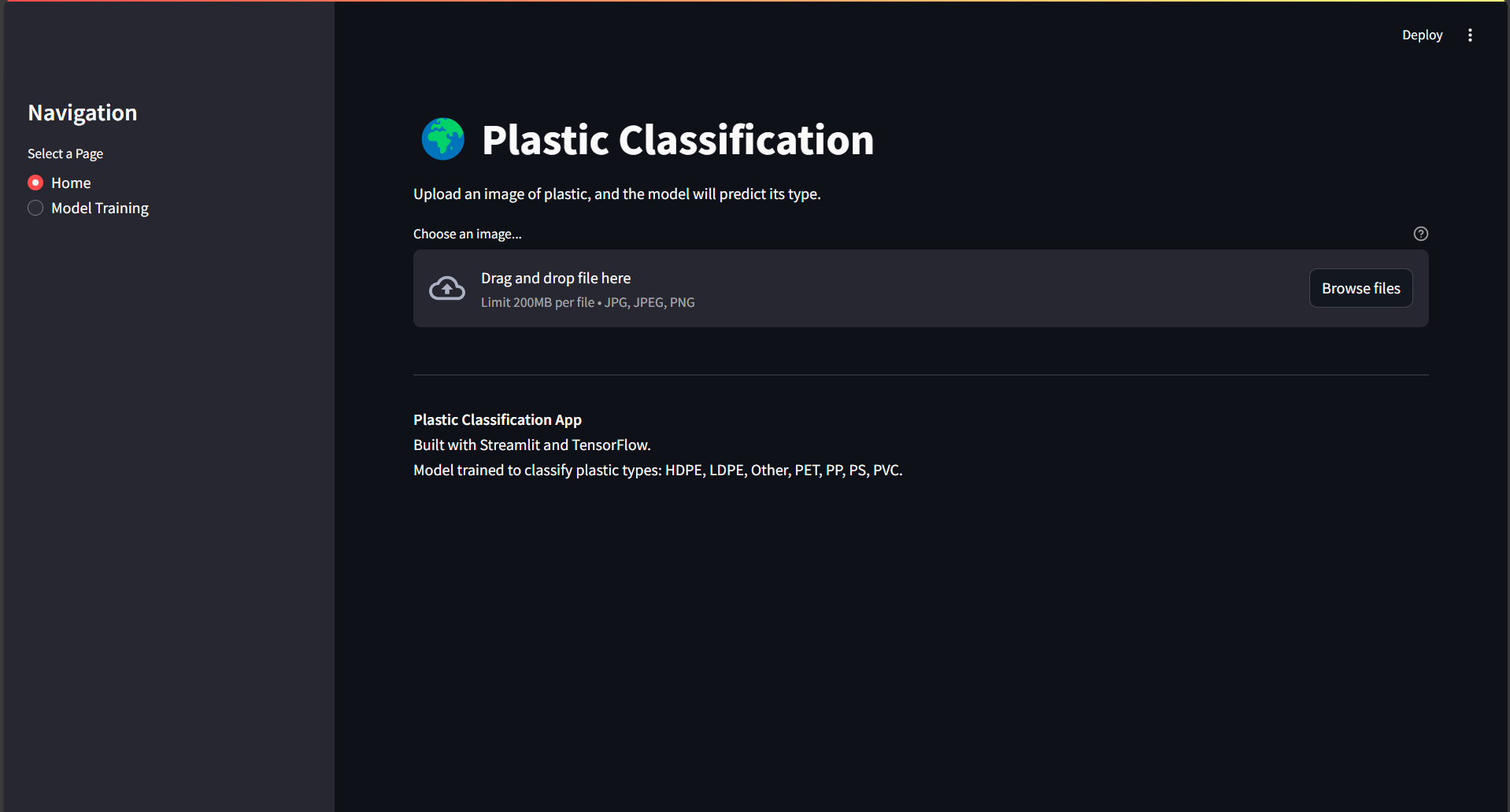Plastic Classification using Transfer Learning
In this blog post, we will walk through the process of building a deep learning model to classify different types of plastic using Transfer Learning with TensorFlow. We will use a pre-trained MobileNetV2 model and fine-tune it for our specific task. The goal is to classify plastic images into one of seven categories: HDPE, LDPE, Other, PET, PP, PS, PVC.
Table of Contents
- Introduction
- Dataset Preparation
- Model Building
- Training the Model
- Model Evaluation
- Visualizing Results
- Conclusion
Introduction
Plastic classification is an important task in recycling and waste management. Automating this process using deep learning can significantly improve efficiency. In this project, we leverage Transfer Learning to build a model that can classify different types of plastic based on images.
Why Transfer Learning?
Transfer Learning allows us to use a pre-trained model (trained on a large dataset like ImageNet) and fine-tune it for our specific task. This approach is beneficial when we have a limited dataset, as it helps in achieving good performance without requiring a massive amount of data.
Dataset Preparation
Dataset Overview
The dataset consists of images of plastic items from seven different classes:
- HDPE (High-Density Polyethylene)
- LDPE (Low-Density Polyethylene)
- Other
- PET (Polyethylene Terephthalate)
- PP (Polypropylene)
- PS (Polystyrene)
- PVC (Polyvinyl Chloride)
The dataset is split into three parts:
- Training set: 1,270 images
- Validation set: 354 images
- Test set: 187 images
Data Augmentation
To improve the model’s ability to generalize, we apply data augmentation to the training set. This includes:
- Random rotation
- Width/height shifts
- Shearing
- Zooming
- Horizontal flipping
train_datagen = tf.keras.preprocessing.image.ImageDataGenerator(
rescale=1./255,
rotation_range=20,
width_shift_range=0.2,
height_shift_range=0.2,
shear_range=0.2,
zoom_range=0.2,
horizontal_flip=True,
fill_mode='nearest'
)
Data Generators
We use TensorFlow’s ImageDataGenerator to create data generators for training, validation, and testing.
train_generator = train_datagen.flow_from_directory(
train_dir,
target_size=IMG_SIZE,
batch_size=BATCH_SIZE,
class_mode='categorical',
shuffle=True
)
val_generator = test_val_datagen.flow_from_directory(
val_dir,
target_size=IMG_SIZE,
batch_size=BATCH_SIZE,
class_mode='categorical',
shuffle=False
)
test_generator = test_val_datagen.flow_from_directory(
test_dir,
target_size=IMG_SIZE,
batch_size=BATCH_SIZE,
class_mode='categorical',
shuffle=False
)
Model Building
Transfer Learning with MobileNetV2
We use MobileNetV2 as the base model for transfer learning. MobileNetV2 is a lightweight and efficient model that is well-suited for mobile and embedded vision applications.
def build_model():
base_model = applications.MobileNetV2(
input_shape=INPUT_SHAPE,
include_top=False,
weights='imagenet'
)
base_model.trainable = False
inputs = tf.keras.Input(shape=INPUT_SHAPE)
x = base_model(inputs, training=False)
x = layers.GlobalAveragePooling2D()(x)
x = layers.Dropout(0.2)(x)
x = layers.Dense(128, activation='relu')(x)
outputs = layers.Dense(NUM_CLASSES, activation='softmax')(x)
model = models.Model(inputs, outputs)
return model
Model Summary
The model consists of:
- Base Model: MobileNetV2 (pre-trained on ImageNet)
- GlobalAveragePooling2D: To reduce dimensionality.
- Dropout (0.2): To prevent overfitting.
- Dense (128 units): Fully connected layer with ReLU activation.
- Dense (7 units): Output layer with softmax activation for multi-class classification.
model.summary()
Training the Model
Compilation
We compile the model using the Adam optimizer with an exponential learning rate decay.
initial_learning_rate = 1e-4
lr_schedule = tf.keras.optimizers.schedules.ExponentialDecay(
initial_learning_rate,
decay_steps=100,
decay_rate=0.96,
staircase=True
)
model.compile(
optimizer=tf.keras.optimizers.Adam(learning_rate=lr_schedule),
loss='categorical_crossentropy',
metrics=['accuracy']
)
Callbacks
We use Early Stopping and Model Checkpoint callbacks to prevent overfitting and save the best model.
early_stopping = callbacks.EarlyStopping(
monitor='val_loss',
patience=10,
restore_best_weights=True
)
model_checkpoint = callbacks.ModelCheckpoint(
'best_model.h5',
save_best_only=True,
monitor='val_accuracy',
mode='max'
)
Training
The model is trained for 50 epochs.
history = model.fit(
train_generator,
epochs=EPOCHS,
validation_data=val_generator,
callbacks=[early_stopping, model_checkpoint, tensorboard_callback]
)
Model Evaluation
Test Accuracy
After training, we evaluate the model on the test set.
test_loss, test_acc = model.evaluate(test_generator)
print(f"\nTest accuracy: {test_acc:.2%}")
print(f"Test loss: {test_loss:.4f}")
Confusion Matrix
We plot the confusion matrix to visualize the model’s performance.
def plot_confusion_matrix():
test_generator.reset()
predictions = model.predict(test_generator)
predicted_classes = np.argmax(predictions, axis=1)
cm = confusion_matrix(test_generator.classes, predicted_classes)
plt.figure(figsize=(10, 8))
sns.heatmap(cm, annot=True, fmt='d', cmap='Blues',
xticklabels=class_names,
yticklabels=class_names)
plt.xlabel('Predicted')
plt.ylabel('True')
plt.title('Confusion Matrix')
plt.show()
plot_confusion_matrix()
Visualizing Results
Training History
We plot the training and validation accuracy and loss to understand the model’s learning process.
def plot_history(history):
acc = history.history['accuracy']
val_acc = history.history['val_accuracy']
loss = history.history['loss']
val_loss = history.history['val_loss']
epochs_range = range(len(acc))
plt.figure(figsize=(12, 5))
plt.subplot(1, 2, 1)
plt.plot(epochs_range, acc, label='Training Accuracy')
plt.plot(epochs_range, val_acc, label='Validation Accuracy')
plt.legend(loc='lower right')
plt.title('Training and Validation Accuracy')
plt.subplot(1, 2, 2)
plt.plot(epochs_range, loss, label='Training Loss')
plt.plot(epochs_range, val_loss, label='Validation Loss')
plt.legend(loc='upper right')
plt.title('Training and Validation Loss')
plt.tight_layout()
plt.show()
plot_history(history)
Training Accuracy & Loss Graph

Confusion Matrix

Conclusion
In this project, we successfully built a deep learning model to classify different types of plastic using Transfer Learning with MobileNetV2. The model achieved a test accuracy of 75.94%, which is a good starting point for further improvements.
Future Work
- Data Augmentation: Experiment with more advanced augmentation techniques.
- Model Tuning: Fine-tune the hyperparameters for better performance.
- Larger Dataset: Collect more data to improve the model’s accuracy.
References
This blog post provides a step-by-step guide to building a plastic classification model using Transfer Learning. The code and explanations are designed to be easy to follow, even for beginners. Feel free to explore the GitHub repository for the complete code and dataset.
